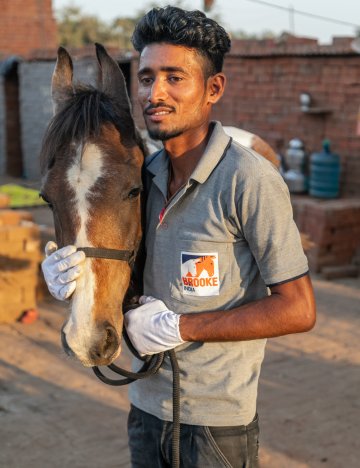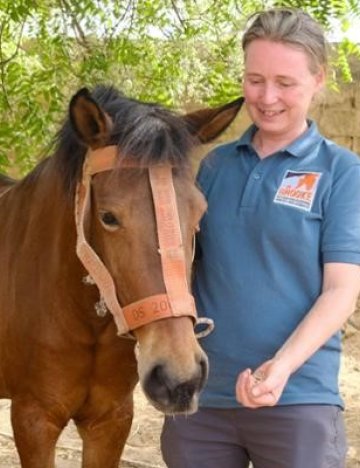The power of compassionate animal handling
Dr Sophie Hill, Brooke’s Equine Behaviour and Handling Advisor, discusses how compassionate handling can reduce stress, trauma and harm for animals, this World Compassion Day.
Whilst many people now recognise the emotional and cognitive capabilities of animals, many animals still experience interactions with people that harm their health and wellbeing.
Compassionate handling is critical in improving animal welfare and creating a better relationship between people and animals.
Compassion is the act of understanding another’s suffering and being motivated to reduce it.
This involves recognising and caring for the emotional, mental and physical needs of animals and understanding the importance of positive experiences.

Compassionate handling means understanding things from an animal’s point of view. It applies to any animal - horse, donkey, mule, cat, hamster or other species.
It involves knowing how animals experience the world through their senses, how they process what they sense, and how this affects their thoughts and behaviour.
Behaviour can give us insights to how an animal feels. By noticing signs of emotion, we can understand how an animal views a situation or interaction and change our actions or the environment to help.
Compassionate handlers know how humans and animals communicate and how what we do affects how animals feel, react and learn. They use skills like understanding signs of emotion and emotional limits, and adjusting actions based on these signs.
Compassionate interactions are calm, two-way conversations between humans and animals that build trust.
Handlers can reduce stress, prevent unwanted behaviours, avoid causing harm and help animals heal from past trauma.
For example, using compassionate handling when a horse gets scared might mean understanding that their senses and emotional reactions are different from ours.
Horses’ eyes detect motion across a wide area and send information to the brain quickly. However, they can’t see as well vertically as humans can without moving their head.
Something fluttering in our view might appear to the horse as a sudden movement from nowhere. This unexpected movement triggers the horse’s sympathetic nervous system, causing the “flight” response, which is why the horse might spook.
By avoiding harsh methods and staying calm, kind and predictable, a compassionate handler can help the horse reduce their nervous system reaction and recover quicker.
For our spooked horse, compassionate handling means offering reassurance, understanding that the horse may now react more strongly to other triggers they subsequently encounter because of the nervous system activation, and acting to reduce stress.
This might include letting the horse move their head to adjust their vision or changing plans to help the horse feel calm again.
Compassionate handling also includes looking at animal welfare, being able to assess an animal’s wellbeing, considering their individual needs, taking steps to reduce negative experiences and promote positive ones.
For example, it’s important to think about the setting where handling happens, including the immediate environment and the animal’s daily and lifetime experience.
If the environment doesn’t meet the animal’s needs, it can make the animal more stressed.
By focusing on welfare, compassionate handlers can create low-stress environments, where animals feel safe, their needs are met and positive interactions can happen.
Compassionate handling has a huge impact on an animal’s wellbeing. We interact with animals daily, often more than we realise!
The effects of these interactions – whether good or bad - add up over time and are long-lasting. Poor handling can cause stress and trauma which can lead to psychological problems like anxiety, learned helplessness and fear, as well as harming their physical health.
Compassionate handling helps break this cycle. Handlers can reduce stress, prevent unwanted behaviours, avoid causing harm and help animals heal from past trauma.
Interactions can become a positive experience that both animals and people enjoy.
Handlers who are kind and patient with animals are less likely to face injuries or accidents. This leads to safer and more effective interactions, promoting a more harmonious relationship.
The challenge now is to make compassionate handling becomes the norm, which requires both individual commitment and systemic change.
As individuals, we can start by closely observing animals to understand their needs, using positive handling techniques, and adjusting our handling based on the animal’s emotional and physical state.
We must also recognise there is always more to learn about our animals’ behaviour and welfare needs.
At an organisational level, institutions and service providers must establish clear standards and guidance that promote best practices.
Brooke has developed a Compassionate Handling Mentoring Framework to help support handlers with the skills they need to work compassionately and effectively with horses, donkeys and mules.
By rethinking how we view human-animal relationships and pushing for standards that prioritise animal welfare, we can create a world where animals can thrive emotionally and physically.
I encourage you to see the world from your animal’s perspective and never underestimate the power of adjusting the environment or handling to improve welfare.

Sophie is Brooke's Equine Behaviour and Handling Advisor and an equine veterinary surgeon, from the Royal College of Veterinary Surgeons.
Having been with Brooke since 2021, she is also a qualified teacher and has worked in educational institutions, including the University of Cambridge, teaching students about veterinary medicines, animal behaviour, welfare and ethics.
